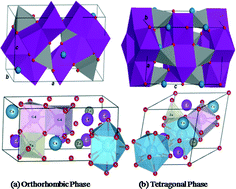Studies on phase stability, mechanical, optical and electronic properties of a new Gd2CaZnO5 phosphor system for LEDs†
Abstract
A new ternary oxide Gd2CaZnO5 having interesting structural, mechanical, electronic and optical properties is synthesized and is studied in detail using density functional theory. The analysis revealed two polymorphs: orthorhombic and tetragonal; the orthorhombic phase was found to be the most stable structure under ambient conditions. A high-pressure (hydrostatic) phase transition to the tetragonal phase is predicted at about 4 GPa. This is one of very few reports that depict the phase transition of oxide materials under pressure. The calculated results are in agreement with the X-ray diffraction studies supported by Rietveld analysis. Analysis of the optical properties revealed both polymorphs to be direct-gap semiconductors with low dielectric constants. The calculated elastic constants of both phases satisfy the mechanical stability criteria. It is also identified that the half-filled 4f orbital of Gd induces a strong magnetic spin polarization in the host oxide lattice indicating that the material could be effectively used in versatile applications ranging from biomedical devices to light emitting diodes.


 Please wait while we load your content...
Please wait while we load your content...